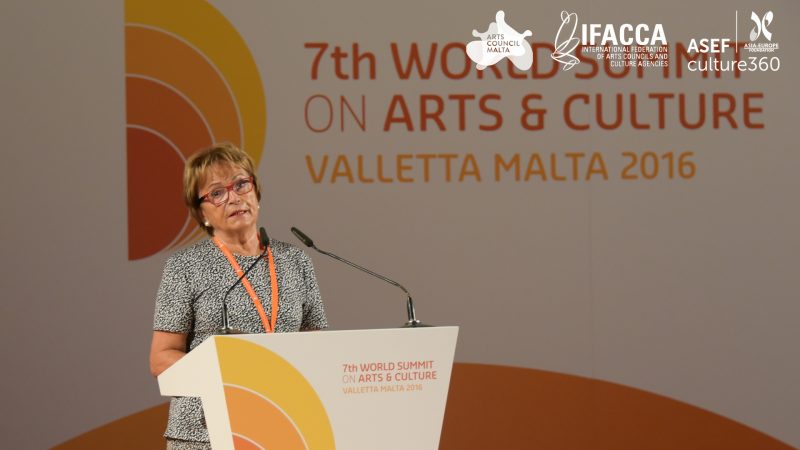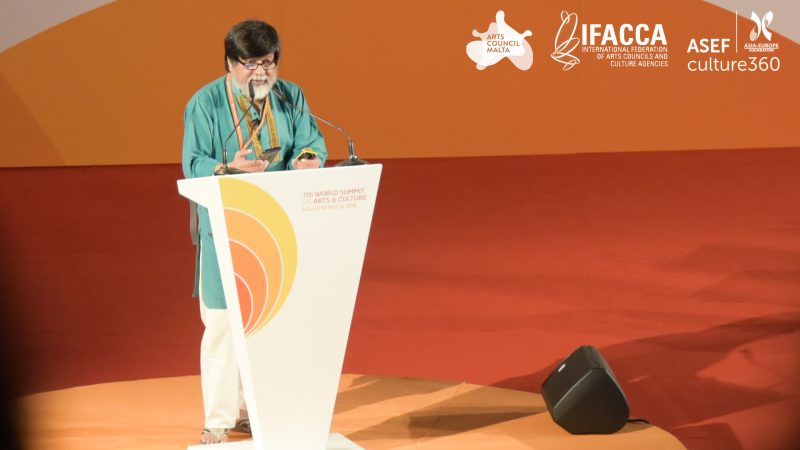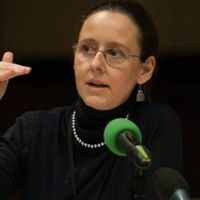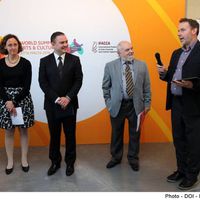7th World Summit on Arts & Culture, Malta I Key Messages

[caption id="attachment_61549" align="alignright" width="348"]
 Valletta, Malta played host to many cultural conferences in October 2016, including the 7th World Summit on Arts & Culture. Photo credit: Fatima Avila[/caption]
Valletta, Malta played host to many cultural conferences in October 2016, including the 7th World Summit on Arts & Culture. Photo credit: Fatima Avila[/caption]The 7th World Summit on Arts & Culture, titled At the Crossroads? Cultural Leadership in the 21st Century took place from 18-21 October 2016 in the historic city of Valletta, Malta bringing together over 380 delegates from 90 countries, including a substantial number from Europe and Asia. It was one of many meetings held in Malta last month gathering civil society, particularly cultural actors including the 15th Assembly of Experts of the European Compendium, the Global Cultural Leadership Programme and the Med Forum 2016 of the Anna Lindh Foundation.
Organised in the framework of Malta’s upcoming presidency of the European Union in 2017 and of Valletta’s designation as European Capital of Culture in 2018, the Summit was co-hosted by the International Federation of Arts Councils & Culture Agencies (IFACCA) and Arts Council Malta. The Summit’s programme was curated by Nina Obuljen Koržinek, who was appointed Croatia’s Minister of Culture even as the Summit was taking place.
Wide-ranging debates took place over 3 days in 4 plenary sessions and 12 parallel sessions, covering topics such as innovative funding models for the arts, cultural leadership training and the changing role of culture in foreign policy. Four key messages may be extracted from the many conversations at the Summit:
#1: Culture: Valuable in itself or subservient to socio-economic objectives? The debate continues
There was widespread affirmation of the power of the arts in developing creativity, generating empathy and imagining better futures. Against the current reality of humanitarian and migration crises, there was a strong consciousness of the necessary role of culture in addressing social issues. At the same time, speakers constantly reminded themselves of the dangers of instrumentalising the arts and making it subservient to broader socio-economic and political considerations and – in the process – denying its inherent value.
[caption id="attachment_61552" align="alignleft" width="329"]
 The absence of a common EU policy remains a major challenge for culture in Europe: Doris Pack, former Chair, European Parliamentary Committee on Culture and Education & keynote speaker at the Summit. Photo credit: Piero Zilio[/caption]
The absence of a common EU policy remains a major challenge for culture in Europe: Doris Pack, former Chair, European Parliamentary Committee on Culture and Education & keynote speaker at the Summit. Photo credit: Piero Zilio[/caption]The creative industries model was also interrogated: can the two approaches – traditional cultural industries (which are in place to develop identity and shared knowledge) and the creative economy (which focuses on generating wealth) – meet, or do economic objectives fundamentally compromise the integrity of cultural projects? At the recent World Culture Forum (11-14 October 2016, Bali, Indonesia), the unequivocal view among experts and delegates in attendance was one in favour of a reaffirmation of traditional and local wisdom; this view was likewise supported, albeit with less fervour, in Malta.
As the place of culture in the changing global environment continues to be entangled in a process of complex negotiation, valuable advice offered by cultural leaders came along the lines of: i. being both strategic and diplomatic when challenging the economic discourse; ii. being consistently involved in the conversation; and, iii. not being afraid of economic measurements of success, while also highlighting alternative examples, success stories, or practical methods as ways of assessing impact.
***
#2: New models of engagement urgently needed in a changing world
In light of funding cuts, many speakers echoed the need for cultural leaders to rethink how they engage not just within the cultural sector, but also with their audiences and with other sectors. Jane Chu, Chair, National Endowment for the Arts, USA summed it up best in her assertion that cultural leaders have been “doing the same things over and over again and expecting different results”. Bucking this trend not only requires leadership capable of making bold investments in new ways of asking questions, but also the creation of conditions conducive for experimenting with new processes of interaction. This call for new models of engagement was also explored in the context of culture’s changing place and role in foreign policy. In the light of the new European Union’s recent Joint Communiqué foregrounding the role of culture in the EU’s external relations, it was debated whether the old-fashioned ‘show & tell’ style cultural diplomacy was finally giving way to a more collaborative model of international cultural relations wherein governments and civil society work together.
With regard to new models of engagement, 3 interesting ideas surfaced during the summit:
Reliable information systems coupled with investment in people-to-people exchange are musts for engagement with ‘others’: For instance, information projects such as the European Compendium project and WorldCP-International Database of Cultural Policies (both strongly endorsed by UNESCO in its Global Monitoring Report 2015: Re|shaping Cultural Policies) should go hand in hand with investment in face-to-face conversations, which have become particularly important in our era of rapid digitalisation.
Culture should engage with other sectors of civil society & with the corporate sector by taking a seat at the discussion table. A sobering observation among speakers and participants was that cultural leaders have for far too long been too insular – often focused on individual survival and sometimes missing the bigger picture and ignoring possibilities for mutual benefit. As thinkers, pioneers and trendsetters, cultural leaders should instead be actively building connections with sectors that, too, can potentially gain from looking through artistic, creative lenses. In light of the debates surrounding the role and value of culture in development and in social transformation, such engagement becomes all the more crucial.
[caption id="attachment_61550" align="alignleft" width="395"]
 Genuine change at the governmental level generally has far greater consequences than change anywhere else: Shahidul Alam, Founder/Director of Drik Picture Library and Chobi Mela Photography Festival, Bangladesh. Photo credit: Piero Zilio[/caption]
Genuine change at the governmental level generally has far greater consequences than change anywhere else: Shahidul Alam, Founder/Director of Drik Picture Library and Chobi Mela Photography Festival, Bangladesh. Photo credit: Piero Zilio[/caption]The culture sector should remain committed to continuous engagement with governments, despite challenges. Acclaimed Bangladeshi photographer, Shahidul Alam argued that governments remain the biggest players in town, and that genuine change at the governmental level generally has far greater consequences than change anywhere else. Hence, the importance of remaining constructively engaged with governments, even as civil societies serve the watchdog function.
***
#3: Towards shared and collective leadership?
The Summit raised 3 interesting questions on cultural leadership:
What leadership is and what is it not: Leadership is increasingly a shared responsibility – it is no longer a function of the often unidirectional broadcasting of a message or vision, neither is it solely about the top jobs in the sector. Instead, it involves deep and mutual listening among various stakeholders, and is more effective when exercised in collaboration with others. Even the collective capacity of an entire community or system to act can be a strong example of leadership. The theme of resilience amidst uncertainty was also reinforced by former Director for Democratic Governance, Culture & Diversity at the Council of Europe, Robert ‘Bob” Palmer. For him, leadership was about “accepting responsibility to create conditions for others to enable them to achieve common purpose in times and under conditions of uncertainty”. Conversely, cultural leadership is not the same as cultural management – it goes beyond the protection of cultural assets, promotion of efficiency, and stewardship of resources. Rather, it involves being grounded and self-critical in decision-making, for it this self-reflexivity that will allow leaders to preempt and understand the problems that can potentially emerge even from seemingly well-intentioned solutions.
[caption id="attachment_61553" align="alignleft" width="354"]
 The 8th World Summit on Arts and Culture will be held in Kuala Lumpur, Malaysia in 2019.[/caption]
The 8th World Summit on Arts and Culture will be held in Kuala Lumpur, Malaysia in 2019.[/caption]What new roles are cultural leaders adopting to stay relevant in these changing times: Future leadership will involve looking outward – adopting a global perspective to decision-making, going beyond one’s local agencies, governments, and frameworks to embrace the power of multilateral cooperation and collaboration. Arts leaders and arts organisations will also be called upon to establish safe spaces for cultural dialogue, both among cultural actors, but more importantly with other sectors. To this end, given that the public often find navigating the processes involved in change-making exceedingly difficult, institutions should begin to explore – much more actively – how they can contribute to public policy that may not be “cultural” per se, but that is more generally directed at facilitating dialogue on social inclusion among peoples and communities.
How best to nurture cultural leaders: A diverse range of leadership development and capacity-building programmes were highlighted in the Summit’s Discussion Paper and at the Summit itself. Examples include the Cultural Diplomacy Platform’s new Global Cultural Leadership Programme, the Clore Leadership Programme, and the Salzburg Global Seminar, among others. One provocative question heard during a coffee-break conversation wondered about the authority backing ‘leadership training’ initiatives (who may ‘train’ leaders and who perhaps may not).
A common takeaway from the experiences of such programmes seemed to be that leadership cannot be successfully developed through standardised, one-size-fits-all training courses on management tools, but needs to be nurtured through new learning models that create space for experience, exchange, and reflection. Programme administrators shared that forum-type programme structures (where cultural leaders engage with one another beyond their comfort zones) are one such way of striking a healthy balance between the imbuing of technical capabilities and the development of “softer” yet equally important qualities such as self-awareness. Looking ahead, cultural leadership programmes must also begin to expand their relevance by reaching outward and creating opportunities for arts leaders at various levels to exchange ideas with their peers from non-cultural sectors. This view of cross-sectorial connections is echoed by Phloeun Prim, Executive Director, Cambodian Living Arts in his essay, Cities: leadership and creativity incubators?:
“We need cultural leaders to have an awareness of issues outside their field and to know how to collaborate outside of the arts; to work with education, with business and with government. They have to work in an international environment, talking to people across cultures, in convincing the language, about how arts can serve the development of the city, and serve a sustainable development agenda in general.” (Cities: Living Labs for Culture?, ASEF, 2015, p. 52)
***
#4: Funding: Making the dollars count
[caption id="attachment_61551" align="alignleft" width="337"]
 Funding organisations should demonstrate deep contextual understanding of their operating environments: Arundhati Ghosh, Executive Director, India Foundation for the Arts. Photo credit: Piero Zilio[/caption]
Funding organisations should demonstrate deep contextual understanding of their operating environments: Arundhati Ghosh, Executive Director, India Foundation for the Arts. Photo credit: Piero Zilio[/caption]Funding has been a longstanding issue of concern for artists and arts organisations. While much of the conversation centered around advocating for increases in public funding, a point of contention was also whether government funding is always good or appropriate. Specifically, there were concerns that public funding models may not be sufficiently flexible for certain types of cultural efforts. To this end, there were strong calls for governments to transform funding models to make grants & other forms of support more diverse and accessible for a wider spectrum of artists, including, for instance, those with disabilities.
Sustained funding for cultural networks was strongly reiterated, which can in turn focus on promoting cultural diversity by supporting collaborations and partnerships that are multilateral in nature. To this end, Arundhati Ghosh, Executive Director, India Foundation for the Arts, emphasised that funding organisations should demonstrate deep contextual understanding of their operating environments as opposed to remote projects held together by fragile connections. Barbara Negron, founder & General Director, Cultural Policies Observatory, Chile, further asserted that beneficiaries should be fully engaged as equal partners – implying a process of learning from within, rather than mere imposition of values and assumptions. The call for project evaluation models involving participating artists (not merely grant administrators) was also loud and clear.
The next edition of the World Summit will be hosted by Malaysia in 2019.
***
- Follow the conversation at #ASEFculture and #artsummitmalta
- Other articles on the 7th World Summit on Arts & Culture:
- Writer & researcher, Kathy Rowland reviews the Summit in "Voices from the Floor: World Summit on Arts & Culture"
- Educator & researcher, Lidia Varbanova’s summary of the 7th World Summit on Arts & Culture.
***
This report was commissioned by the Asia-Europe Foundation (ASEF) and written by Daniel HO Sheng with inputs from Anupama SEKHAR.
Similar content
posted on
25 Oct 2016
deadline
05 Feb 2016
posted on
01 Dec 2015
posted on
28 May 2015






